S.B.I.G. MODEL ST-7E ENHANCED CCD IMAGING/STAR TRACKER SYSTEM:
Another step in the evolution of CCD imaging technology - and again led by SBIG!
FEATURES OF S.B.I.G. MODEL ST-7E ENHANCED DUAL CCD SYSTEMS:
Continuing their tradition of innovation, in October 1994 SBIG introduced the original ST-7 (and ST-8) cameras with an unique concept (Patented) for astronomical imaging: each ST-7 series head contains two CCD's in parallel; a Kodak KAF0400 for imaging, and a Texas Instruments TC211 for tracking. In February 1999 the ST-7E was introduced.
The Model ST-7E is a multi-purpose instrument available either in non-Anti-Blooming Gate (non-ABG) or ABG enabled configurations, which feature a unique two CCD arrangement in parallel. Based upon the original SBIG Model ST-7 dual chip camera concept, the ST-7E adds a dramatic improvement in sensitivity while maintaining an extremely low dark current. These new enhanced Kodak CCD detectors have higher QE (Quantum Efficiency) not just in the blue where the original Kodak detectors were relatively weak, but across the entire visual spectrum - from the UV to the IR. These new ST-7E (and ST-8E) cameras have higher QE in the blue and green than even the venerable SBIG Model ST-6 CCD system!
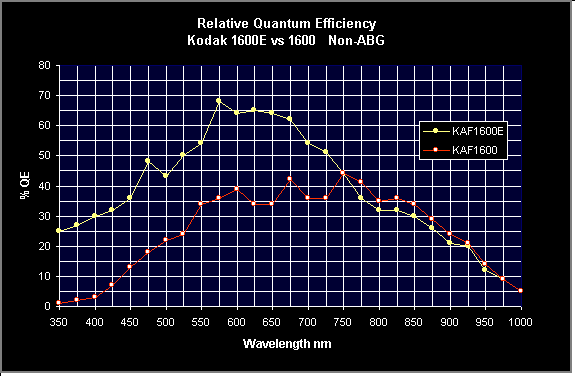 |
The chart above shows the QE results for sample KAF-1600E and KAF-1600 detectors (used in the ST-8 non-ABG series) tested under identical conditions. The two samples clearly demonstrate the new version of the detector is much more sensitive than the standard KAF-1600 from the UV to the IR. The enhanced detector has good UV sensitivity even out past 350 nm! Assuming that the standard ABG detectors are roughly 30 to 50 percent less sensitive than the non-ABG detectors, then the enhanced non-ABG detectors are as much as four times as sensitive as the standard ABG detector across the visible spectrum, and ten times as sensitive at the far end of the blue spectrum. We have compared standard ABG cameras to the new enhanced non-ABG camera at the telescope and the enhanced non-ABG camera yields approximately 4 times the signal as a standard ABG detector under similar conditions. The difference is quite dramatic.
As of February 1999 the ST-7E and ST-8E were available without ABG (Antiblooming Gate) enabled. In June 1999 we announced the availability of ABG detectors available for delivery commencing in October 1999. As with prior chips, the ABG versions will suffer some loss of sensitivity due to the ABG structure.
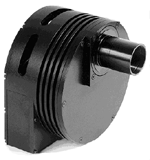
Keeping with their tradition of treating their customers with respect, SBIG and Company Seven are instituting generous upgrade programs: from the prior ST-7 to the new ST-7E, and from the ST-7 to ST-8 or ST-8E. Please read our price listing, or contact Company Seven for the current price and availability.
The dual CCD chip arrangement of the ST-7 and ST-8 series cameras permits:
- When used with a personal computer (Macintosh or PC) can function as an integrating, cooled CCD camera
to capture monochromatic images of very faint objects. Carefully designed for astronomical and scientific imaging.
The ST-7E camera head incorporates a Texas Instruments TC-211 and the Kodak KAF-0400E enhanced detector which permit simultaneous guiding and imaging thereby eliminating the need for optional guide telescopes, or off axis guiding hardware to accomplish CCD imaging. Also this eliminates any possibility of guiding errors caused by differential flexure of guide telescopes or mirror shift.
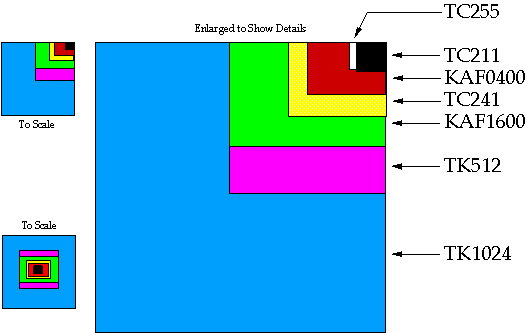
(Illustration 1. Relative Size of Common Astronomical Imaging CCD's)
- Horizontal: 57.3/Focal Length of Objective (mm) * 6.9
- Vertical: 57.3/Focal Length of Objective (mm) * 4.6
- When used with the optional SBIG CFW-8 Color Filter Wheel then the ST-7E camera can function to produce tricolor images; these can then be combined (indexed and
balanced) to produce color images.
- When the camera (controlled by a personal computer) is installed on a photoguide telescope, or at the guide port of an off axis guiding device then the ST-7E can detect any deviations in tracking of a telescope (in both axes) and then send correction signals via a relay cable to a telescope drive corrector controller. All of this is done with a better frequency, higher accuracy and over a longer period of time than most humans can perform. All of this resulting in professional quality astrophotographs limited only by the quality of the telescope, and atmosphere.
- The SBIG ST-8E and ST-7 series CCD instruments will accept the new SBIG Model AO-7 Adaptive Optics technology to reduce the adverse effects of atmospheric turbulence during astronomical (or possibly terrestrial) imaging. There is no other family of production CCD instrument that will accept this patented innovative option.
The ST-7E camera head features a female "T-thread" which accepts a variety of adapters to attach the head onto a telescope, microscope, or other system. Furnished with each head are a male nose piece of 1.25" diameter (threaded to accept filters), and another of 2" (threaded for 48mm filters). A quiet, no vibration fan vents at the rear of the head to assist with the cooling functions. Connectors on the head are a female 5-pin DIN for power, a male 25 pin "D" to a computer parallel port, and a female 9 pin "D" connector to the telescope drive corrector/hand corrector for autoguiding or to an optional SBIG Color Filter Wheel. Included cables are the 25 pin "D" female to male, a male to male RJ cable with an adapter for the female RJ to male 9 pin "D" adapter. A power supply is furnished (standard 115V or optional 12 V.D.C.).
THE ST-7/ST-7E STAR TRACKER FUNCTION:
Each head contains two CCD's in parallel; a Kodak KAF0400E for imaging, and a Texas Instruments TC211 for tracking. The two CCD's are mounted onto a common pedestal on top of the thermoelectric cooler within the CCD head housing. These CCD's share an Analog to Digital converter, and other readout electronics. In operation, the TC211 portion of the CCD camera detects a star slightly outside the field of view of the Kodak imaging CCD chip, and it generates the signals which then drive the relays thereby adjusting the telescope tracking. The geometry of the Models ST7 and ST-7E is illustrated in Figures 2 and 3. The ST-8 and ST-8E concept is similar but, the CCD imaging area is larger than that of the ST-7 series.
The TC211 is identical to the chip used in the popular SBIG Model ST-4/4X guiding systems, and in practice the ST-7 tracking technique is very similar to the ST-4, except the ST-7 integrated concept has evolved to allow the TC211 to acquire and guide on fainter stars. In practice, up to the evolution of these cameras users have employed two separate CCD systems; one for guiding and another for imaging. And up to the introduction of the ST-7, no one else has rendered it successful within one single head thereby allowing quicker and easier setup and operation, less complicated cabling, and simpler computer and power requirements.
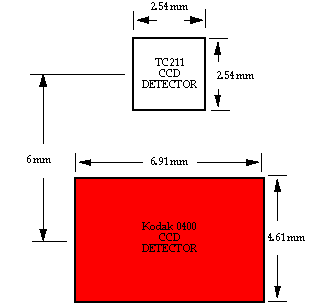
(Illustration 2. The Chip Arrangement within the Model ST-7E CCD Head)
The Model ST-7E camera interface to the telescope consists of a cable from the normally closed/open connector to the telescope drive corrector or hand control. The camera will produce drive adjustments usually commanded by the telescope drive corrector push button switches. A manual override on the computer keyboard allows the corrections to be made by the user.
By making fine adjustments to the telescope via the computer keyboard, a guide star can be moved onto the detector, or even onto any particular pixel. However, a guide star does not have to be centered onto the CCD detector for the system to function properly. The user can select the length of the star tracker exposure times from 0.1 to 20 seconds (default is 1 second); so stars ranging over 10 magnitudes in brightness can be tracked without adding optional filters. The area of pixels to be used (guide box) can also be adjusted to accommodate very long focal length guide telescopes, or mediocre atmospheric seeing conditions.
AUTOMATIC DRIVE CALIBRATION: Once an acceptable star is found, and when focus is achieved, the operator will select "Calibrate Drive" function so the CCD system will "learn" the characteristics of the telescope drive. The software sequentially activates relays via the camera head output which send a user selectable 1 to 10 second signal to the telescope drive corrector to move the telescope North-South and back, then East and West and back; the telescope will end up returned to the point at which it started. This function "teaches" the CCD system what commands will cause the telescope to move in what direction, and how fast. This calibration feature is invaluable when using a German equatorial mount, or an off axis guider, where the proper direction can be very difficult to guess.
Then the operator will select "Track"; any drifting motion of a star across the CCD causes it to appear at a different pixel at each following exposure. The computer controlling the CCD will then calculate how far the star has drifted and generates a control signal, transmitted through the relays to correct the position. The control signal, and its duration are a function of the star's position error. The camera system can take an exposure (integration), read out all the pixel values, and then calculate and transmit the necessary telescope correction in less than one second.
In the "Track" mode the camera acquires a fresh star image, centers the image on a pixel, and holds that star in position by constantly monitoring it - sending correction signals to the telescope drive immediately after the exposure. The CCD is thermoelectrically cooled to enhance its sensitivity to dim stars. This extreme sensitivity enables guide stars as faint as 8th magnitude to be tracked utilizing as small as a 60mm guide telescope. The rapid calculating power of the computer enables the guide star location to be determined within a fraction of a pixel, enabling better than 1 arc second tracking accuracy. An alarm signal is actuated if a guide star is lost.
Specifications of Model ST-7E Dual CCD System Detectors
| Imaging Resolution: | 765 x 510 Pixels, Class I Kodak KAF0400E CCD |
| Imaging Pixel Dimensions: | 9 micron square |
| Imaging Array Dimensions: | 6.9mm x 4.6mm, 8.3mm Diagonal |
| Guiding Resolution: | 192 x 164 Pixels, Texas Instruments TC211 CCD |
| Guiding Pixel Dimensions: | 13.75 microns x 16 microns |
| Guiding Array Dimensions: | 2.64mm square, 3.73mm Diagonal |
| Anti-Blooming | Available |
Specifications of Model ST-7E (non-ABG) Electronics
| Binning | 2x2 Noiseless/Software Selectable |
| Full Well Unbinned (in Ke-): | 85,000 |
| Full Well Binned 2x2 (in Ke-): | 40,000 |
| Readout Noise (in e-): | 15 RMS Double Correlated Sampling |
| Dark Current | <0.2e-/pixel/sec @-10 degrees C |
Specifications of Model ST-7E Hardware
| Desiccant: | Yes, internal & replaceable |
| Standard Control Software: | PC Windows or Win95 |
| Communications Port: | Parallel |
| Analog/Digital Converter: | 16 Bit |
| Digitization Rate, Full Frame: | 11.5 secs. at 33 KHz |
| Shutter: | Electro-Mechanical |
| Fastest Shutter Speed: | 0.11 Sec. |
| Longest Shutter Speed: | 1 Hour |
| Cooling From Ambient: | -35 Degrees |
| Power Requirements: | 115V.A.C. Provided (12 v.d.c. optional) |
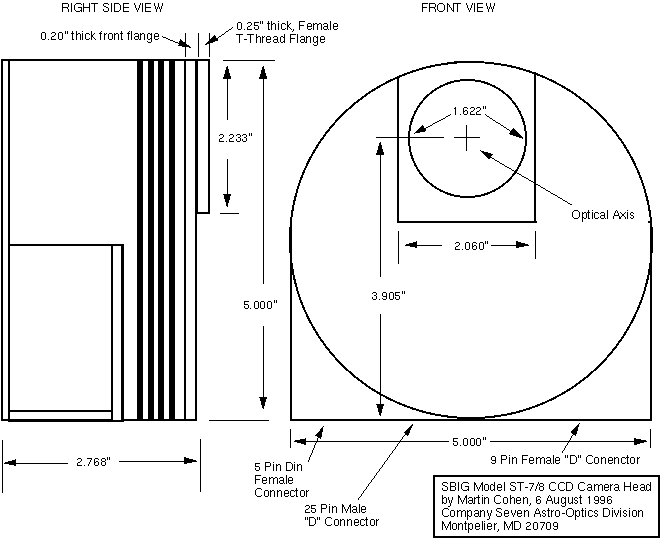
(CLICK IMAGE TO ENLARGE)
POPULAR AVAILABLE OPTIONS FOR THE S.B.I.G. ST-7E:
- Company Seven can provide wiring diagrams of most common production telescopes to illustrate
to the user how to wire the provided relay cable into the telescope.
- Model AO-7 Adaptive Optics System with "CCDSHARP" software
- Model CFW-8 Color Filter Wheel
- A variety of nosepieces to fit microscopes, or other devices
- Model FR-4 Focusing Ring Collar
- A variety of optional and third party Image Processing Software
- Parfocal Eyepiece to help to find, center, and focus an object
- Camera Lens Adapter
Go back to SBIG Products page
Contents Copyright 1994-99 Company Seven All Rights Reserved